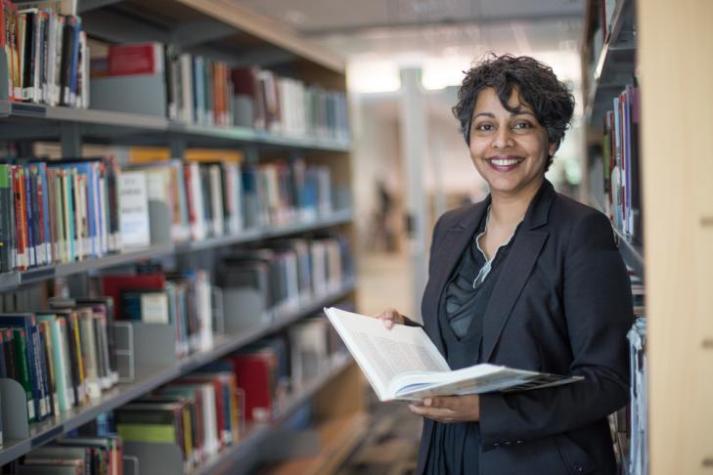
Associate Professor Rhema Vaithianathan of the SMU School of Economics is studying how Asia's ‘silver tsunami’ is changing the way we care for the elderly.

Photo Credit: Singapore Management University
By David Tan
SMU Office of Research (11 Oct 2013) – Singapore’s swiftly ageing population is in the spotlight once again. Figures released in September 2013 showed that the proportion of Singaporeans aged 65 and above jumped by 50 percent in the last decade to 11.7 percent of our citizen population today. While this trend has many worrying about the pressures on our economy, society and governance, it is a source of inspiration to Associate Professor Rhema Vaithianathan, a health economist and expert on ageing at the Singapore Management University (SMU).
Professor Vaithianathan is a Senior Research Fellow with the SMU Sim Kee Boon Institute for Financial Economics (SKBI) Centre for Silver Security (CSS). She is also an Associate Professor of Economics at the University of Auckland in New Zealand.
Healthcare financing in Singapore
“I find Singapore fascinating; it’s such an unusual system. I’m very excited by the policy making in Singapore,” Professor Vaithianathan says. She points to the Central Provident Fund (CPF) and Medisave schemes as being unique examples of how the government can spend so little on healthcare yet build one of the best healthcare systems in the world with both low infant mortality and high life expectancy.
A key issue Professor Vaithianathan is studying is healthcare financing. “I’m interested in issues of ageing in Singapore and the impact of ageing on the use of resources,” she says. “I’m very interested in healthcare financing reform in Singapore, the way Medisave works, and how it could be strengthened with pay-as-you go insurance.”
Fascinated by the treasure trove of data about citizens collected by government agencies and healthcare providers for administrative purposes, Professor Vaithianathan is using this data to perform predictive risk modelling. The overall aim is to develop automated algorithms to identify high-risk individuals who may require emergency intervention for the benefit of not only themselves, but also the community.
In one such collaboration with Khoo Teck Puat Hospital (KTPH), a public hospital managed by Alexandra Health, Professor Vaithianathan is studying patterns of hospital visits to predict which patients are most likely to visit the hospital repeatedly.
“If you can predict who’s at most risk of coming back to the hospital in the next six months, you might be interested in deploying community-based services to try and keep them out of the hospital,” she explains.
By alerting relevant stakeholders of high-risk individuals, whether doctors and nurses on issues of healthcare, or law enforcement on issues of security, Professor Vaithianathan believes that this would allow for more efficient use of national resources.
Gerontocracy in Japan
Professor Vaithianathan’s interest in ageing populations extends across Asia, and in this field, researchers are invariably drawn to Japan, the country with the oldest population in the world.
Several years ago, she travelled to Hitotsubashi University in Japan on a foreign scholar project grant to conduct research with Professor Reiko Aoki, a former colleague at the University of Auckland.
One aspect that interested them was the disproportionate voice of the elderly in Japan. “At the moment, Japan has many pro-elderly policies”, she says, “making reform in favour of child-friendly policies very difficult to achieve.”
“Japan is unusual in that the minimum voting age is 20 and in general the voting population is very old, which makes it difficult for Japan to undertake any pension reform,” she explains.
To tackle this problem, Professor Vaithianathan and Professor Aoki advocate a system called Demeny voting, where children can have an electoral voice by allowing parents or guardians to vote on their behalf. In doing so, the median age of voters is reduced, which means the voting demographic is less weighted toward those of pensionable age, giving pro-child policies a greater chance of being passed.
Looking to China
Turning her focus towards the largest country in Asia, and indeed the world, Professor Vaithianathan gets very excited when discussing China, a country which is also experiencing an ageing crisis.
“I’m very interested in Asia in general, and in particular China. I’ve just finished a nutrition project in China looking at the impact of the Great Chinese Famine on survivors and their children,” she says.
In collaboration with two researchers at the Australian National University, Professor Vaithianathan looked to address a key question: Can we use anthropometrics – or physical measurements such as height and weight – as a summary statistic of economic conditions?
The researchers analysed data from the China Health and Nutrition Survey collected during the Great Chinese Famine from 1958 to 1961. They were keen to study why despite the high death rates there was no discernible decrease in height among those exposed to famine during their crucial growth years.
Professor Vaithianathan’s team found that although growth was stunted during the famine, the calamity imposed a selection for survivors and those genetically predisposed to robustness tended to be tall.
Other findings revealed that females suffered more than males and rural communities fared worse than urban populations during the famine. The study concluded that raw height was not always a good measure of economic conditions during childhood.
Motivated by the outcome of her studies in China, Professor Vaithianathan says she hopes to do more research there. “I think it’s amazingly interesting what’s happening with healthcare financing reform there,” she says, adding that she is now looking for collaborators with access to interesting datasets in the country.
See More News
Want to see more of SMU Research?
Sign up for Research@SMU e-newslettter to know more about our research and research-related events!
If you would like to remove yourself from all our mailing list, please visit https://eservices.smu.edu.sg/internet/DNC/Default.aspx
